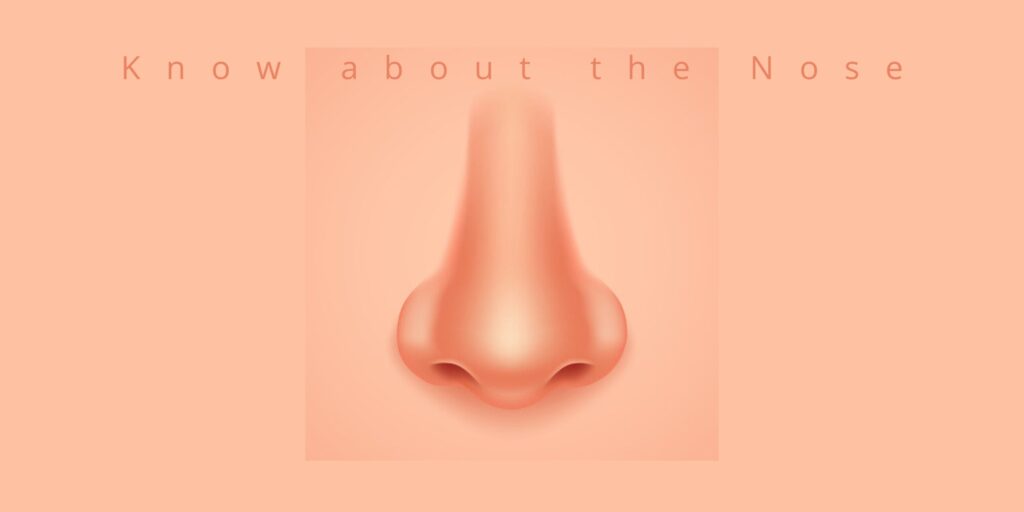Functions of the nose
The functions of the nose are appropriately explained in this article. The nose is a prominent part of the face that is right in the middle, between the eyes. It is the entrance to the respiratory system and is where the olfactory organ is located.
The anatomy of your nose includes:
- Bone is what makes up the rigid bridge at the top of your nose.
- Hair and cilia: Hair and cilia, which look like tiny hairs, trap dirt and other particles inside your nose. Then, they move those particles toward your nose, where you can sneeze them out or wipe them away.
- Lateral walls (outer walls): Your nose’s exterior walls are made of cartilage and skin. The walls make up the inside of your nose and your nostrils.
- Nasal cavities: Your nose has two hollow spaces called nasal cavities where air can flow in and out. They have mucous membranes on the inside.
- Nerve cells: These cells talk to your brain so that you can smell things.
- Nostrils, or nares, are the openings on the face to the nasal cavities.
- Septum: Bone and firm cartilage make up the septum. It moves down the bridge of your nose and divides your nose into two parts.
- Sinuses: You have four sets of sinuses. Your nasal cavities are linked to these air-filled pockets. They make the mucus that keeps the inside of your nose wet.
- Turbinates (conchae): Three pairs of turbinates are on each side of each nasal cavity. These folds within your nose aid in warming and moistening the air you breathe, making it easier for your nose to drain.
Role of the nose
The nose is involved in several critical biological processes, such as:
- Your nose is where the air goes in and out of your body.
- Your nose can change how you look and sound when you talk.
- The nasal cavity cleans and filters the air, removing dust and allergens.
- The nose is what makes us able to smell.
- The nasal cavity warms and moistens the air before it enters the respiratory system. This facilitates the passage of air into the lungs.
Your nose is an integral part of both how you look and how you feel about yourself as a whole, so it’s essential to take care of it.
Helping the process of respiration is included in the functions of the nose. The actual process of breathing starts in the nose. When we let the air out of our lungs, the oxygen comes out of the nose through the same holes it went through. These holes are called nostrils.
There are holes in the nasal cavities that lead to the choana. The choana then has holes that lead to the nasopharynx. The air then goes through the oropharynx, the larynx, the trachea, and the bronchi before getting to the lungs.
Health problems of the nose
Among the health problems that can affect your nose, we can list:
- Infection: Many of the same symptoms that come with allergic rhinitis can also be caused by an infection. Sinus infections and the common cold are two examples.
- Nosebleed (epistaxis): When a blood vessel in your nose breaks, you get a nosebleed. Most of them aren’t serious, but they happen often.
- Allergic rhinitis: Also called “hay fever,” allergic rhinitis causes irritation, a runny or stuffy nose, and sneezing.
- Nasal valve collapse is the most common reason for a blocked nose. It can be caused by an accident or injury to the nose.
- A deviated septum is when your septum isn’t in the middle. This can happen at birth or after you get hurt. It can make breathing hard, make your nose stuffy, and give you headaches.
- Nasal polyps are bumps that can stop air from moving through your nose or stop your nose from filtering the air.
- Allergens and irritants can cause the turbinates to swell, which can block airflow and make it hard to breathe normally.
- Nasopharyngeal cancer: Head and neck cancer can start in your nose.
- Injury or trauma: Your nose can be broken or hurt like any other body part.
Helping the sense of taste is included in the functions of the nose. As you chew, your food breaks into smaller pieces and gives off certain chemicals. These chemicals end up in the nose, stimulating the smell receptors. They work together with the taste buds to figure out the exact flavour of the food being eaten.
How can I keep my nose in good shape?
- At all costs, try not to smoke or breathe in smoke from other people.
- Because they keep dust and other small particles out of the nose, nose hairs shouldn’t be pulled out or should be done very carefully.
- Make sure you drink lots of water.
- It’s crucial to keep your home clean so that you don’t breathe in as much dust and other allergens. The best way to get rid of dust from your bedsheets is to wash them.
- Every so often, saline should be squirted into the nasal canals to keep them moist and clean.
- A humidifier can be used to keep the moisture level in the air at home.
Smelling is one of the functions of the nose. When you take a breath, air touches the olfactory epithelium. At the same time, nerve fibres that reach out from the olfactory receptors start to gather molecules that make up the smell. The receptors then use these molecules to send signals to the olfactory bulbs. These impulses are sent to the part of the brain that is in charge of smell. There, they are decoded so that the scent can be identified.



